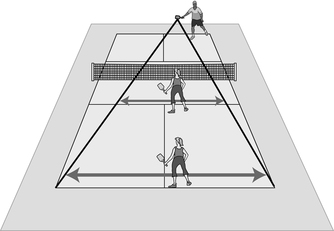
Being as close to the net as possible provides a huge advantage. You don’t have to move as far to hit a ball, as shown in the diagram above: the woman at the net has much less distance to traverse to return the man's shot when she's at the NVZ. You’re also able to hit balls to the back court more easily and safely because you need less power and the angles are better. Finally, from the NVZ you can dink.
But how do you get there safely?
Current wisdom says your third shot should be a drop shot into the NVZ just over the net. Some players ask why, since you'd be inviting the opponent who's in the back court to run up to the NVZ. As I said earlier, chances are she's already done that, and the drop shot allows you time to move up, too. It also softens the game, making it nearly impossible for your opponents to hit a hard drive your way. When executed well, the ball lands low and soft, and your opponents must return the ball softly to make it over the net.
Executing drop shots and dinks well and consistently requires practice. Lots of it. But that practice pays off when you can remove the opponents' advantage and level the play.
The other thing new players find difficult is to stand right behind the NVZ line with toes almost touching it. They lag back in midcourt or a few feet from the line because they're afraid they might step into the NVZ and volley. With practice, that doesn't happen often, and knowing where the NVZ is becomes a sixth sense. The main reason to stand close to the line is that your opponents can't target your feet. The height of the net makes that impossible when you're close to the line. Stand farther back and your shoes are perfect targets.
When you are forced into the back court (by a lob, for example) during a rally and your opponents are at the net, you can turn to the drop shot again. Your hit has to be soft enough to bounce low, giving you time to run up again, and to prevent them from slamming the ball back. If you don't feel competent with the drop shot, a lob will also work.

 RSS Feed
RSS Feed